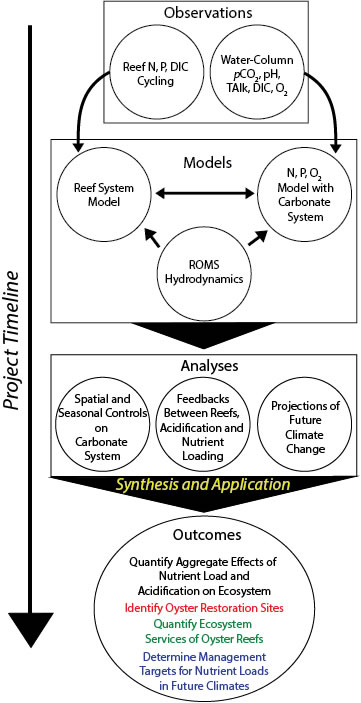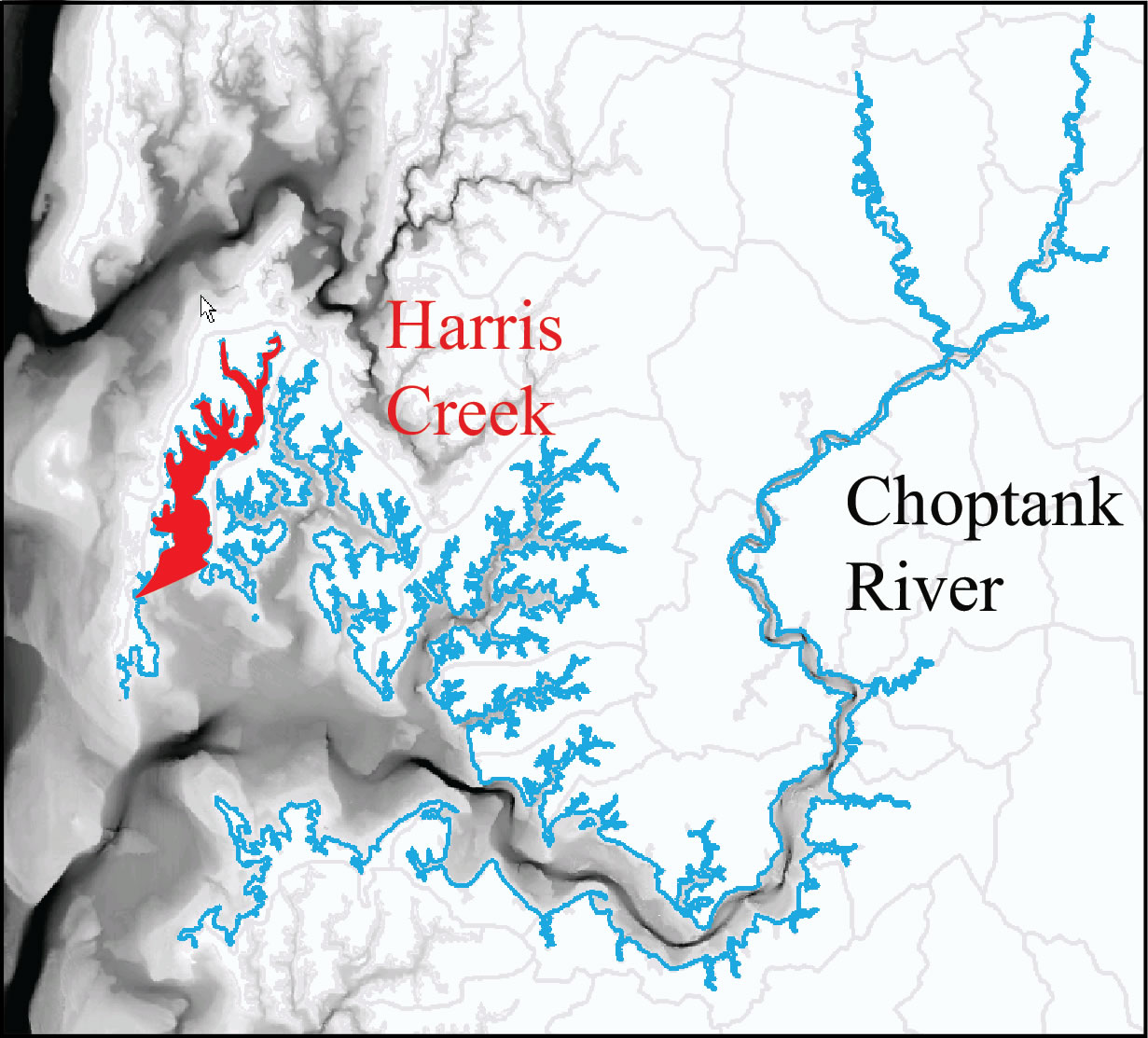Modeling Dynamics of Shallow Estuaries: The Chester River estuaryWe are developing models to simulate hydrodynamics, primary production, respiration, and nutrient cycling in the Chester River estuary, a tributary of Chesapeake Bay. Shallow-water habitats are key components of many coastal ecosystems. These habitats often reside at the land-water interface and mediate the transfer of land-derived materials to deeper, subtidal regions. Because light penetrates to the sediment surface in many shallow systems, submerged aquatic vegetation and benthic algal communities often inhabit these environments. These benthic communities alter nutrient and carbon cycling, but also provide food and habitat for many important organisms Because shallow-water areas constitute the majority of Chesapeake Bay (76% of area < 10 m), nutrient and sediment dynamics in these habitats can have important consequences for Bay ecology. Chlorophyll-a and dissolved O2 can vary substantially over the course of a day in shallow-water systems (D'Avanzo and Kremer 1994, Tyler, et al. 2009), due to the compressed water-column and strong interaction with metabolically-active sediments. Therefore, modeling shallow-water ecosystem dynamics and their response to alterations in physical forcing and nutrient loading presents an interesting challenge. Shallow-water systems may also have different nutrient load response curves than their deeper, water-column-dominated counterparts.Modeling shallow-water ecosystem dynamics and their response to alterations in physical forcing and nutrient loading presents an interesting challenge. Collaborators: Damian Brady, Kelly Cole, and Ming Li |
Funding Provided by
|
Forecasting Summer hypoxia in Chesapeake BayWe are interested in the development and application of ecological forecasts in estuaries and coastal ecosystems. Working with the Integration and Application Network, University of Michigan and the National Oceanogrpahic and Atmospheric Administration (NOAA), we are developing and implementing annual forecasts of summer hypoxic and anoxic volumes in the Chesapeake Bay estuary. Tune in to our forecasts every June and explore our past forecasting efforts at the Integration and Application Networks website. Collaborators: Caroline Donovan, Bill Dennison, Don Scavia, and Rebecca Murphy
Funding Provided by National Oceanic and Atmospheric Administration |
|
Modeling the Phenology of Coupled Human-Watershed-Estuarine SystemsChesapeake Bay’s watershed area (164,200 km) contains diverse ecological and physiographic features and complex human-environmental interactions. A relatively large ratio of watershed area to estuary surface area (~14.3), coupled with the long (18,800 km) dendritic shoreline, render the estuary closely connected with its surrounding watershed. The current population of the watershed is ~16,000,000 people, most of whom are concentrated in and around metropolitan areas, which are generally located near the fall line of tributaries. The population is projected to reach 19,000,000 by 2030.Associated with population growth and land use changes, much of the watershed has also seen rapid increases in nutrient inputs from the variouse sources. Effective planning and policy development for assuring the sustainability of estuarine water quality requires the development and application of fully integrated models that can simulate estuarine ecosystem responses to plausible scenarios of alternative future conditions of land use, land management, climate, and weather, as in turn influenced by policy choices and human behavior.This project intends to use both qualitative measures of human responses and quantitative tools of climate and land use to build a set of plausible future scenarios for land use, climate and weather for the CBW. Collaborators:Bill Ball, Damian Brady, Zack Easton, Ciaran Harman, W. Michael Kemp, Ariel Ortiz-Bobea, Lisa Wainger
|
Funding Provided by the National Science Foundation
|
Interactions of Eutrophication and Ocean Acidification in Chesapeake BayOyster populations have received widespread attention in recent years for a variety of compelling reasons, including their functional extinction in most coastal zones, significant federal, state and local initiatives for restoration, and the documented detrimental effects of acidification on aquaculture. The decline in oyster populations is also of interest because they provide the valuable ecosystem services of particle filtration and nutrient removal, thereby influencing the widespread coastal eutrophication problem. Of the many challenges to oyster restoration, ocean acidification has only recently emerged as a topic of interest in estuaries and coastal zones. This is in part due to the complexity of processes that influence carbonate chemistry across multiple temporal and spatial scales in these dynamic habitats, but also because eutrophication coupled with increasing atmospheric CO2 results in additive acidification effects on carbonate chemistry. These barriers to restoration, combined with gaps in data on carbonate chemistry, limited understanding of organismal interactions with acidification, and future uncertainty in nutrient loads and climatic conditions, present a formidable research and management challenge. The objective of this project is to make significant strides in bridging the gap between scientific knowledge and current management needs by integrating existing biogeochemical model frameworks, field measurements, and experimental efforts. Collaborators: Wei-Jun Cai, George Waldbusser, Jeffery Cornwell, Ming Li, Michael Kemp
|
Funding Provided by
|
Filtration and Nutrient Cycling on Restored Oyster ReefsIn this study, we aim to couple a fine-scale, individual-based model of oyster reef filtration to a sediment biogeochemical model and an oyster reef nutrient cycling model to understand the role of oysters in driving biogeochemical cycling in an oyster reef. We also aim to test how sensitive oyster impacts are to the size, shape, and orientation of the reef itself. This model will be used to examine a series of restored oyster reefs in a large-scale project within Harris Creek, which is a tributary of the Choptank River in the Chesapeake Bay ecosystem. Click here to explore Harris Creek oyster restoration
Collaborators: Lora Harris, Elizabeth North, Larry Sanford
Funding Provided by National Oceanic and Atmospheric Administration |
|







